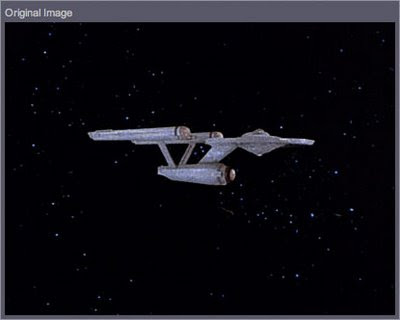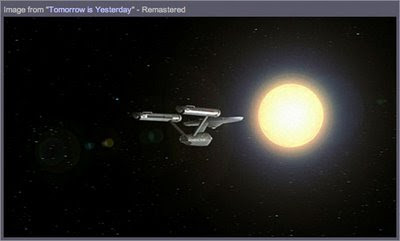 I recently came across a nine-year-old article to which I contributed. Frank Garcia was looking for visual effects professionals' opinions on the idea of creating new visual effects for the original "Star Trek" episodes. The article, from January 2000, was written in the shadow of the Special Editions of the "Star Wars" trilogy and "Close Encounters of the Third Kind," each of which featured newly created visual effects.
I recently came across a nine-year-old article to which I contributed. Frank Garcia was looking for visual effects professionals' opinions on the idea of creating new visual effects for the original "Star Trek" episodes. The article, from January 2000, was written in the shadow of the Special Editions of the "Star Wars" trilogy and "Close Encounters of the Third Kind," each of which featured newly created visual effects.
CBS Digital ultimately performed visual effects facelifts to the episodes, and has since released them on video and broadcast. You can learn everything that Paramount wants you to know about the remastered episodes at startrek.com, which features plenty of articles and before-and-after comparisons.
I contributed to the article, "Special Effects Redux," and my comments hold up surprisingly well. I'm always hesitant to read some of my old writing and interviews, (a few of the reviews on VFX HQ still make me cringe) but am happily satisfied that, in this case, I made an ounce of sense. I still am of the opinion that these 'special edition' revisits are ridiculous and purely driven by commercial concerns, rather than artistic merit.

 'I'm very much an advocate of preserving the past and looking forward to try and create new classics. Which is the current, most accurate film? Are we going to get special editions with every film every 10 or 20 years? When a film comes out I'm assuming already 'Okay, this is the first pass, the rough draft.' '
'I'm very much an advocate of preserving the past and looking forward to try and create new classics. Which is the current, most accurate film? Are we going to get special editions with every film every 10 or 20 years? When a film comes out I'm assuming already 'Okay, this is the first pass, the rough draft.' 'On the other hand, Vaziri recognizes the allure of a compelling idea. 'It was such a refreshing change to see in DEEP SPACE NINE's 'Trials and Tribble-ations' the technology and the detail we can get today of the space station and the Enterprise. It was an interesting gimmick. Replacing the SFX of a single episode, that would be kinda cool. You put it on UPN and get great ratings. But to get into it for the entire series or a couple of episodes, is ridiculous.'
Vaziri also has strong feelings from an artists' point of view. 'I think of the people who toiled feverishly over the original STAR WARS, getting the shots and how revolutionary they were. The original SW shots that were replaced, they'll never be seen again!' Although Vaziri recognizes that the original STAR WARS releases will live on with DVDs and videotape, he says, 'The Special Edition is the 'final edition.' 'They made those episodes as well as they could with the money they had,' he says. 'Don't betray their efforts just because, oh, 20 or 30 years have passed and they can do it much better now.'
Asked if it is likely for Hollywood to develop a practice of replacing SFX on other iconic film or TV projects, Vaziri replies that the bottom line is economics. 'It could be profitable,' he says. 'The studio executives have to look and say, 'Are we going to spend to revamp this 30 year old film?' Studios are even reluctant to making new video transfers. They think it's not worth it. I think it will be very sparse.'


If there are any sins in Hollywood, in the way that visual special effects are produced, says Vaziri, are those projects that are spectacle over substance. 'I'm constantly pushing towards the use of SFX as a portion of the film,' he says. 'Not as a character gimmick or 'Hey! Look at me!' The best films are always about stories and characters. The SFX creates the worlds in which they live. In rare cases, the SFX are the characters, like JURASSIC PARK or THE PHANTOM MENACE where an entire character is being generated as SFX. For the most part, they should never take center stage. They shouldn't draw attention to themselves. The best SFX I've ever done are the ones people haven't noticed because they were so caught up with the film. We did about 50 or 60 visual effects for A STIR OF ECHOES, and there were only two or three that were really 'in your face.' Nobody noticed any of the other SFX. That's a big compliment because the work doesn't draw attention to itself. People don't walk out of the theater saying, 'Wow! Great SFX!' I think invisible is important.'
Contextual usage of SFX as part of the film is also very important, says Vaziri. Sinful 'spectacle over substance' effects films includes THE AVENGERS, LOST IN SPACE and GOZILLA, says Vaziri. In the case of a Digital Stream-created STAR TREK vision, Vaziri also has a problem with the forced comparison between the original and a new edition. 'That's extremely distracting. You're going to see an episode where the sets were so cheaply made that you can see a little gap on the floor and then you cut to this new, perfectly detailed CGI SFX shot? It totally does not fit within the context of the film! It takes you out of the film and draws attention to itself. If new SFX are made for 'The Doomsday Machine,' they're out of place and context. It draws attention to them rather than being a service to the story and characters.'

